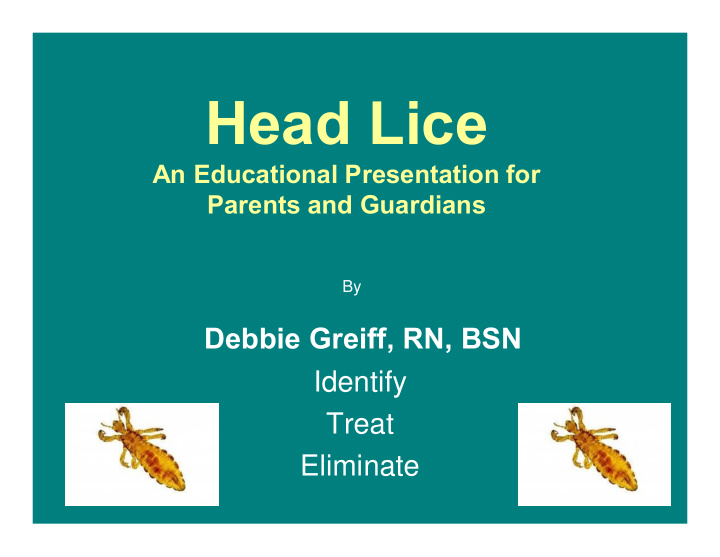



Head Lice An Educational Presentation for Parents and Guardians By Debbie Greiff, RN, BSN Identify Treat Eliminate
HEAD LICE AND HUMAN HISTORY • Head lice have been found on Egyptian mummies. • Pre Columbian human remains show evidence of head lice infestations. The National Pediculosos Association (2009)
The CDC Estimates there are 6-12 Million Cases of Head Lice Annually Most of these cases are preschool and elementary school age children and their household members • Great expense and nuisance to the community • High anxiety for parents and guardians • Misinformation and improper treatment • Stigmatization and finger pointing in and around the school community
Head Lice Facts • Head lice do not imply a lack of cleanliness. • Head lice do not jump or fly. • Transmission usually occurs by direct contact; head lice rarely spread through contact with personal belongings. However, it is prudent to teach children not so share personal items such as combs, brushes and hats. • It is impossible to prevent all head lice infestations; but, prompt identification and treatment can minimize the transmission to others. Pediatrics (2010)
HEAD LICE DO NOT TRANSMIT DISEASE THEY ARE JUST AN ANNOYANCE
Identify an Active Case of Head Lice • Finding a live louse on the head. • Identifying nits (eggs) that are firmly glued to the hair shaft, ¼ to ½ inch from the scalp. • Often, but not always, a sensation of itching or something crawling through the hair is noticed by the child.
Treatment • Contact your child ’ s Primary Care Provider to get a recommendation for treatment that is best suited for your child ’ s needs. • If a pediculicide is recommended, follow the directions for the product exactly. Pay attention to the amount of pediculicide applied and the amount of time the product should remain on the hair. • Comb ¼ inch sections of hair daily, with a fine toothed lice comb, to remove lice and nits. • For two weeks examine hair daily in small ,¼ inch sections and remove nits until no nits or lice are seen. Checks can be slowly tapered off to once a week.
Comb Comb Comb Individual nits can be slid down the hair shaft, pulled off at the end , and disposed of. Always dispose of nits and lice in the trash . Do not throw them on the floor.
A WORD OF CAUTION Do not use products that are not intended for use on skin. This includes kerosene, mayonnaise, or insecticide . Do not use room fogger sprays. They are not necessary and can be toxic. Centers for Disease Control and Prevention (2010)
Supportive Products Olive oil and petroleum jelly are sometimes used to smother the persistent lice that do not respond to initial treatment. Apply generously. Cover with shower cap for 8 hours. Wash out and comb. This step may require many applications of shampoo.
Environmental To prevent re-infestation, these tasks can be done once after the initial treatment is completed. • Remove all bedding and wash in hottest water for fabric and dry at hottest heat. Wash all coats and sweatshirts. Wipe down all backpacks and helmets. • Either replace all hairbrushes and combs or soak these items for 20 minutes in water that has boiled and been removed from heat. • Vacuum all rugs, floors, and furniture, including family vehicles. Wipe down car seats. • All stuffed animals and decorative pillows , that can ’ t be washed, should be put in the dryer, on high heat, for 20 minutes. • Items that can not be heat treated, washed, or vacuumed , should be packed in large plastic bags and stored for at least two weeks.
Questions? Don ’ t hesitate to stop in or call me. My contact information is: Debbie Greiff, RN, BSN Hillside Elementary School Nurse 781-455-0461 x228 Debbie_Greiff@needham.k12.ma.us
References and Resources Andresen, A, McCarthy, A.M.(2009 A policy change strategy for head lice management. Journal of School Nursing, 25, 407-416 doi: 10.1177/105984050347316 Centers for Disease Control and Prevention(2010). Parasites-lice-head lice, November www.cdc.gov/parasites/lice/head Frankowski, B., Bocchini, J. Jr, (2010) Head lice, Pediatrics ; July, 2010, doi: 10.1542/peds.2010-1308
Hootman, J. (2002). Quality improvement projects related to pediculosis management. Journal of School Nursing, 18, 80-86. doi: 10.1177/10598405020180020401 Kolar. K.(2005) Research to reality: applying findings to practice. Journal of School Nursing, 21, 182-183. doi: 10.1177/11598405050210031101 Natural History Museum (2004), Head lice and early humans, www.nhm.ac.uk/about- us/news/2004/oct/news_3960.html The National Pediculosis Association (2009). Old comb reveals nits on the nile. www.headlice.org/news/classics/nitsonthenile.htm
Recommend
More recommend